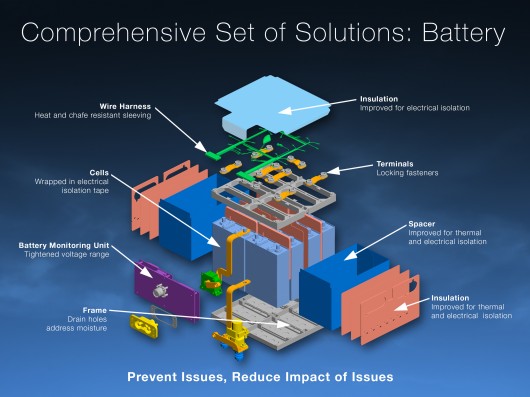Boeing outlines additional safety features for 787 batteries
By David Szondy
March 16, 2013
Boeing is confident that the redesign of the lithium-ion batteries and added safety tests will fix the safety issue
Boeing has announced improvements to the lithium-ion batteries for its 787 Dreamliner. A series of modifications to the batteries and their casings were made in response to battery fires in mid-January aboard two 787s in Boston and over Japan that resulted in all 50 of the planes delivered to customers being grounded. According to a company press release, the modifications along with improved testing regimes should prevent a repeat of the incidents.
The lithium-ion batteries have been a sensitive spot for Boeing because of the cloud that it cast over the new 787 Dreamliner. Exactly what caused the fires is still undetermined, but Boeing is confident that the redesign of the lithium-ion batteries and added safety tests will fix all the possible causes that Boeing and aircraft safety experts identified. If the modifications pass evaluation by the U.S. Federal Aviation Administration (FAA) and other international regulators, the 787 may return to service within a few weeks.
Lithium-ion batteries are part of Boeing's plans to move away from conventional onboard power systems that rely on a mixture of auxiliary power units and pneumatics to one where more electricity is used. The idea is to create a system that is lighter, cleaner and simpler by replacing pneumatic units and piping with electrical versions and wiring.
This approach requires using lithium-ion batteries due to their high amperage, low weight and fast recharge times. Unfortunately, the same heating problems that have plagued such batteries in laptops and electric cars can also effect aircraft – which is where the series of proposed changes come in.
"Our first lines of improvements, the manufacturing tests and operations improvements, significantly reduce the likelihood of a battery failure," said Mike Sinnett, vice president and chief project engineer, 787 program, Boeing Commercial Airplanes. "The second line of improvements, changes to the battery, helps stop an event and minimize the effect of a failure within the battery if it does occur. And the third line of improvements, the addition of the new enclosure, isolates the battery so that even if all the cells vent, there is no fire in the enclosure and there is no significant impact to the airplane."
Battery manufacturing now includes four new or revised tests for screening batteries, bringing the total number of tests to ten over a fourteen-day period with discharge rates being measured on an hourly basis.
As to the batteries themselves, design changes include two new insulation layers including one of phenolic glass laminate. An electrical insulator is wrapped around each battery cell to electrically isolate them from one another and the battery case and there’s more electrical and thermal insulation on top, below and between the cells to isolate them in the event of overheating. Wire sleeving and the wiring inside the battery have been upgraded to make them more heat and chafing resistant. New locking fasteners have been added to the bars connecting the cells.
The case for the battery has also been redesigned to keep the batteries away from other electrical equipment. It has a stainless steel enclosure held in place by titanium fixtures and there are vents in the case to allow moisture to drain from the bottom and to vent gases overboard while preventing oxygen from getting to the batteries to support combustion. The enclosure can withstand the failure of eight battery cells and forces one and a half times greater than any projected failure. Under tests, it withstood three times the force.
"We put this new design through a rigorous set of tests. We tried to find a way to introduce a fire in the containment but it just wouldn't happen. Even when we introduced a flammable gas in the presence of an ignition source, the absence of oxygen meant there was no fire," says Sinnett.
These steps to improve battery safety have not come without a cost. The modifications have added 150 pounds (68 kg) more weight to the 787, which negates part of the reason for using lithium-ion batteries in the first place.
Source: Boeing
Copyright © gizmag 2003 - 2013 To subscribe or visit go to: http://www.gizmag.com

